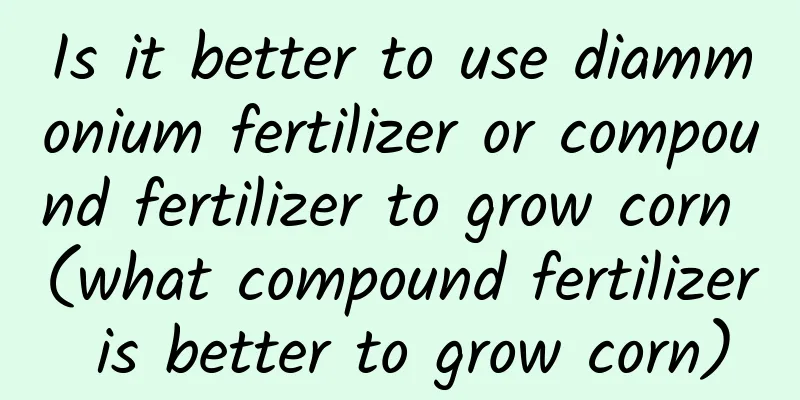Is it better to use diammonium fertilizer or compound fertilizer to grow corn (what compound fertilizer is better to grow corn)

Is it better to use diammonium phosphate or compound fertilizer for corn?In the process of growing corn, most farmers use chemical fertilizers such as diammonium phosphate, compound fertilizer, and urea. When it comes to corn planting, I believe many people have a question during the fertilization process, which is whether I should use diammonium fertilizer or compound fertilizer? Diammonium phosphate is also a compound fertilizer containing nitrogen and phosphorus, so compound fertilizer is the ternary compound fertilizer containing nitrogen, phosphorus and potassium that we all know. So which one should we use? According to corn experiments in various places, if nitrogen and phosphorus are used together, corn yields can increase by about 10%. However, if nitrogen, phosphorus and potassium are used together, the yield increase can reach 30%. Therefore, it is best to use nitrogen, phosphorus and potassium together for corn . The biggest difference between diammonium phosphate and compound fertilizer is that diammonium phosphate only contains nitrogen fertilizer and phosphorus fertilizer, containing 18% nitrogen fertilizer and 46% phosphorus fertilizer. Compound fertilizers are generally triple compound fertilizers, which contain nitrogen, phosphorus and potassium and are relatively comprehensive in nutrients. No matter what plant is being grown, nitrogen, phosphorus and potassium are indispensable. However, from a planting perspective, the emphasis of the content used in each period is different. We have done a lot of experiments and found that the rational use of potassium fertilizer during the corn maturity period can increase corn yield by more than 20%. However, diammonium phosphate does not contain potassium fertilizer, which is the defect of this fertilizer. Generally, when corn is in the maturity stage, we will supplement potassium fertilizer by spraying potassium dihydrogen phosphate on the leaves, so that the corn will mature quickly and the yield will increase. When using compound fertilizer in the process of growing corn, we generally use compound fertilizer with high nitrogen, medium phosphorus and low potassium. Because nitrogen fertilizer can make corn plants grow quickly, and phosphorus fertilizer can make corn take root quickly, so that it can better absorb nutrients in the soil. Finally, potash fertilizer can promote the maturity and yield of corn. From this point of view, diammonium phosphate only contains nitrogen fertilizer and phosphorus fertilizer. Although the content is high, it also has certain limitations for increasing yield and maturity in the later stage. What compound fertilizer is best for corn?The ratio of nitrogen, phosphorus and potassium in corn compound fertilizer depends on the corn variety: The ratio of nitrogen, phosphorus and potassium in spring corn is about 1:0.3:1.5, and it needs to absorb 3.5-4.0kg of nitrogen (N), 1.2-1.4kg of phosphorus (P205) and 5-6kg of potassium (K20). The ratio of nitrogen, phosphorus and potassium in summer corn is about 1:0.5:1.5, and it needs to absorb 2.5-2.7kg of nitrogen (N), 1.1-1.4kg of phosphorus (P205) and 3.7-4.2kg of potassium (K20). Of course, corn absorbs nutrients differently in different growth stages. Compared with summer corn, spring corn absorbs nitrogen and phosphorus more concentratedly, and the absorption peak is also earlier. Generally, spring corn absorbs only 2.2% of the total nitrogen in the seedling stage (before jointing), 51.2% in the middle stage (from jointing to heading and flowering), and 46.6% in the late stage (after heading). Summer corn absorbs 9.7% of the total nitrogen in the seedling stage, 78.4% in the middle stage, and 11.9% in the late stage. Spring corn absorbs phosphorus, accounting for 1.1% of the total absorption in the seedling stage, 63.9% in the middle stage, and 35.0% in the late stage; Summer corn absorbs 10.5% of phosphorus in the seedling stage, 80% in the middle stage, and 9.5% in the late stage. Corn's absorption of potassium increases rapidly after jointing in both spring and summer, and reaches a peak during the flowering period. The absorption rate is high, which can easily lead to insufficient potassium supply and symptoms of potassium deficiency. |
<<: How to propagate petunia (how to grow petunia seeds and what to pay attention to)
Recommend
How to propagate chrysanthemum
Cutting propagation time of lover's chrysanth...
Disease control of strawberry
1. Leaf spot Also known as snake eye disease, it ...
What kind of sweet-scented osmanthus tree is good to plant in the garden (it is suitable to plant Japanese sweet-scented osmanthus in the family garden)
In fact, when planting osmanthus trees in the cou...
How to ensure water temperature in aquaculture in winter?
In the process of aquaculture , winter management...
Corn Planting Conditions Planting Areas and Climate Requirements
Corn Introduction Corn is a very important food c...
Can peonies be planted in pots?
Can peony be planted in a flowerpot? Peonies can ...
Bougainvillea pruning
1. Pruning method 1. Shortening method: This meth...
How to reproduce Datura
Seed propagation of Datura Datura is usually prop...
How to propagate blue flower
Cutting propagation of blue flower dandelion Cutt...
Causes and treatments for yellowing leaves of Silver Star
1. Temperature is too high Reason: It is not cold...
There are many flowers you don’t need to keep in winter, except these 6 kinds, you will lose a lot if you don’t keep them!
Grow a pot of Clivia and enjoy its flowers and le...
Dahlia cultivation tips
Dahlia, a perennial herb belonging to the Asterac...
Does Andrographis paniculata prefer shade or sun?
Does Andrographis paniculata prefer shade or sun?...
How to grow mirror grass
How to grow mirror grass soil The soil for pottin...
Steps of hydroponics
1. Cut branches When you first start hydroponics,...









